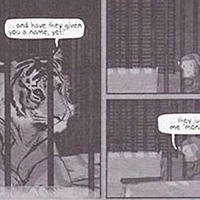Animal Viewpoints in the Contact Zone of Adam Hines’s Duncan the Wonder Dog
DOI:
https://doi.org/10.52537/humanimalia.9952Abstract
Duncan the Wonder Dog by Adam Hines is an autoethnographic text about the contact zone, as Mary Louise Pratt describes both terms. I will be using this method of postcolonial analysis not to show how the graphic novel allegorizes postcolonialism among human beings, but instead to demonstrate how postcolonialism offers useful tools for understanding the posthumanism of animal subjectivity. After placing Hines’s graphic novel within the range of graphic novels using animal viewpoints, I will analyze how both text and illustrations of Duncan the Wonder Dog negotiate the great difficulties of presenting animal viewpoints, at once acknowledging and contesting the inevitability of such presentations as anthropomorphic. Pratt’s contact zone emphasizes the importance of pictorial communication in the contact zone to overcome problems of transmission using a variety of pictorial styles, and thus the range of scholarship on picturing animals, from John Berger to Eileen Crist, will be a crucial part of my examination.
Downloads

Published
Issue
Section
License

This work is licensed under a Creative Commons Attribution-NonCommercial 4.0 International License.








